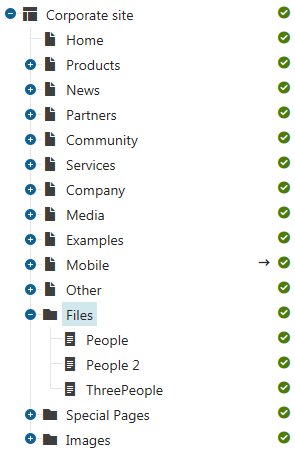Managing files
Kentico allows you to upload files (such as GIF, JPG, SWF, PDF, XLS, DOC, etc.) to the Kentico database or file system and manage them as any other content.
File management approaches in Kentico
If you need to upload files to the Kentico database or file system, you need to distinguish between four types of files:
- File management approaches in Kentico
- Importing multiple files into Kentico at once
- CMS.File pages
- Page attachments
- Media libraries
- Unmanaged files
Importing multiple files into Kentico at once
You can use two approaches to upload multiple files into Kentico at once:
- In the administration interface - using page attachments and media libraries
- On the server file system - using media libraries
CMS.File pages
These files are uploaded by content editors as new CMS.File pages into the content tree. You will typically use this type for files that are used as part of unstructured pages, such as page links or images inserted into editable regions of pages. We also recommend storing these files within folders (CMS.Folder page type).

Page attachments
These files are stored as a part of a structured page and their life cycle is also bound to the page (including workflow and versioning). You can have an unlimited number of files attached to a page.
You can find a detailed description and examples in Attaching files to pages.
Media libraries
We recommend the Media libraries application to store large amounts of files. You can use files in media libraries to create image galleries, video galleries or as a way of managing larger amounts of files of different types. The application and its typical usage is described in Media libraries.
To upload multiple files at once, see Inserting files into media libraries.
Unmanaged files
Unmanaged files are files that are part of your web project and are stored in the project’s local file system. For example, an unmanaged file can be a file linked from your web site. These files are not managed by the system.
On Portal Engine sites, CSS and JavaScript files can be (partially) managed from the CSS stylesheets and Javascript files applications. These applications can serve as shortcuts for accessing and editing files located in the corresponding folders in the file system, ~/App_Themes folder for the CSS stylesheets application and ~/CMSScripts folder for the JavaScript files application. However, CSS and JavaScript files are not managed by the system itself, and can be therefore considered as unmanaged.